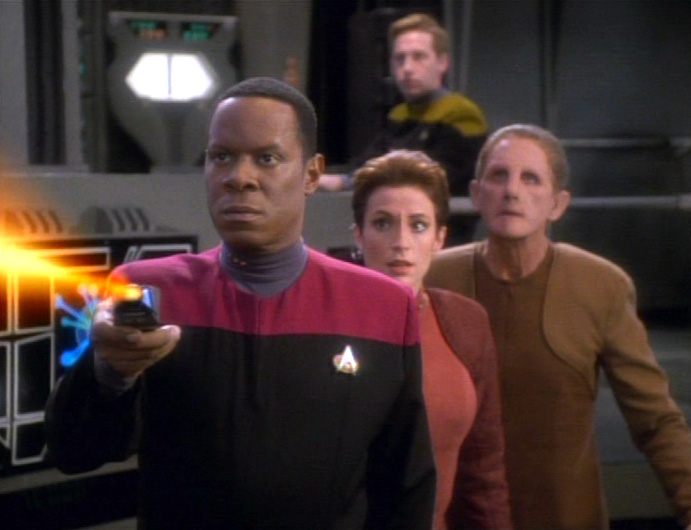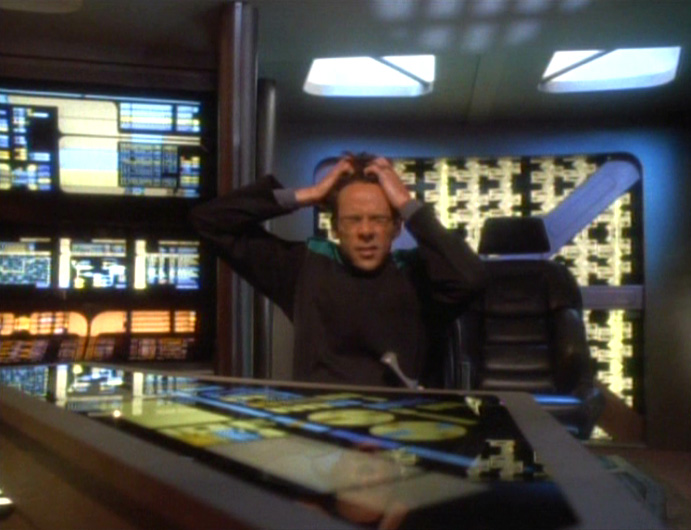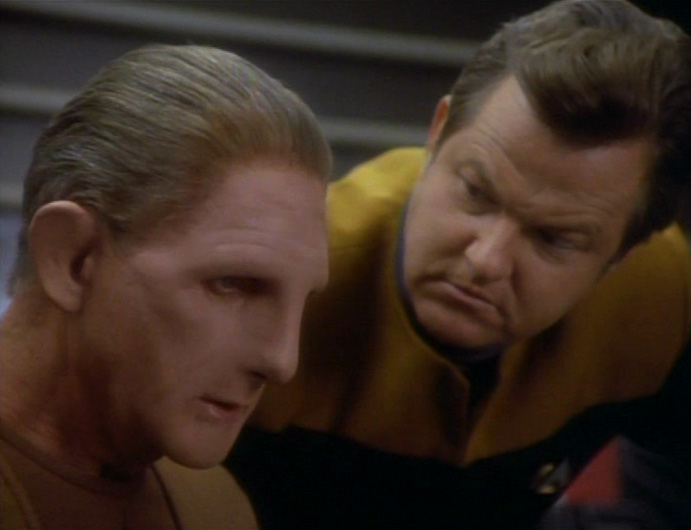There is a theory that every Star Trek show has its “Kirk character,” a dashing young man who performs daring feats, gains a reputation as a ladies’ man, and generally fills the role of the action hero as required by any particular episode. That basically describes the version of Kirk that has persisted in the wide cultural consciousness as well as parts of the narrower fandom, rather than the somewhat more nuanced character that was actually created in the original series. (And especially the movies, where the focus on his age (as all of the first ten Star Trek movies are, to varying degrees, about the fact that the cast is old) put a different spin on the action elements when they arose.) In The Next Generation, this basically describes the common conception of Commander Riker: the character is the first officer now rather than the captain, but he’s still the leader of most away missions, gets to do more than his share of fighting, and has several love interests of varying superficiality, even while the character is shown to be extremely hesitant about assuming a command of his own. He’s built to fill several of the roles that Kirk did, while the role of the captain is filled by a wiser, more thoughtful figure.
In Deep Space Nine the “Kirk character” is problematized much more. As originally conceived and as portrayed thus far, Doctor Julian Bashir is an arrogant, fresh-faced young man who is long on ambition and short on wisdom. He is prone to speak at length, but has little to say. He might fancy himself a man of action, asking Odo where he might practice his phaser aim as soon as the crisis is resolved at the end of “Emissary,” but when he gets into a fistfight in “Dax” he makes a distinctly poor showing for himself. And his attempts at womanizing have been as facile as they’ve been unsuccessful: his attempts to woo Dax have been commented on at length already, including his very first scene in the series; even aside from Dax, he was shown breathlessly telling one woman a thrilling story about his medical exams at the beginning of “Q-Less,” then proceeded to make what he might have considered some suave moves on Vash almost as soon as she showed up on the station. So far, Bashir is a callow young man trying to fill a role that’s too big for him.
(In Voyager, meanwhile, the “Kirk character” is literally a convicted criminal. Enterprise works a little differently, as that show attempts to give those characteristics back to the captain in the throwback spirit of a prequel; how successful Enterprise is in this endeavor, as in any other it attempts, is left as an exercise for the reader.)
In “The Passenger,” the first Deep Space Nine episode to focus largely on Bashir, it’s only too appropriate that he’s subject to another trope that’s been present in Star Trek almost as long as there’s been Star Trek: bodily possession. From Janice Lester’s bid to break out of her society’s boundaries in “Turnabout Intruder” to Ira Graves’ bid to break out of his frail human body in “The Schizoid Man” to, most recently as of early 1993, the Ux-Mal prisoners’ attempt to break out of their planet-bound cage in the above-average “Power Play,” Star Trek has prodigiously borrowed the trope from the larger culture. It’s so common a plot element, actually, that for “The Passenger” to be a worthy addition it has to offer some new twist on the concept, or use it to constructive purpose in furthering some aspect of DS9 as a series.
Sadly, “The Passenger” does nothing of the sort. Its main twist on the idea is to play it like a straightforward horror film: the episode begins with a near-silent shot of a runabout flying alone in space, rather than the traditional warm reading of Dennis McCarthy’s Deep Space Nine theme underscoring an establishing shot of the station; Kajada stabbing Rao Vantika’s former body to make sure he’s actually dead is a nice moment thanks to its suddenness, and not a little reminiscent of vampire stories; at one point Vantika appears out of the shadows like a deadly apparition; Vantika himself combines the deranged serial killer, the mad scientist, and the zombie for a horror triptych. Other than the stark quality of the episode’s first seconds, none of this is particularly clever or striking. Frankly, during the same time period as the production of “The Passenger,” The Next Generation was doing somewhat better in terms of combining Star Trek settings and plots with horror tropes, a particular interest of writer Brannon Braga and something he’s making his name doing at this time.
It also doesn’t help that this is the first time DS9 relies solely on technobabble to resolve the crisis of the week. Any modern Star Trek show is going to have its share of jargon to some degree, but more often than not DS9 episodes manage to come to their climax through the choices of the characters. In “The Passenger,” Dax uses a scan of Vantika’s neural energy patterns to design an electromagnetic pulse that can travel along a tractor beam before Vantika can engage his ship’s warp engines, which would have torn the ship apart and spread deadly deuridium all over the system; after that fate is averted, Dax is able to program a miniature transporter to isolate glial cells with Vantika’s neural pattern and beam them out of Bashir’s brain into a micro-containment field. The main problem with technobabble (and particularly Treknobabble) is that focusing exclusively on Star Trek‘s technology alienates the viewer from the drama, especially when the technical details have been invented just for one story. It does much better with the smaller detail of Vantika leaving Bashir’s combadge in the infirmary so that he can’t be tracked, since DS9 has invoked that use of the combadge several times in previous episodes. (It also doesn’t help that in addition to its specially-constructed technology, “The Passenger” repeats one depressingly common bit of pseudoscience when Bashir declares that “A humanoid uses only a small portion of the brain.”) There’s very little attempt to invest any of these actions with the characters taking part in them, though the climax is nearly redeemed when Bashir is beamed back to the station, says it’s him and not Vantika in possession of his body, and Sisko promptly stuns him with a phaser blast just to make sure he won’t be a problem. Perhaps Sisko truly is a man of action as “Q-Less” promised.
Doctor Bashir was notoriously underdeveloped during Deep Space Nine‘s pre-production. There had to be a doctor because every Star Trek show has a doctor, but other than the general intention of making him unlikeable at the beginning of the show there wasn’t much planned for his character. An actor can interpret this in two ways: the fact that the character is broadly drawn can be either an indication that nobody in the production or writing staff quite cares about them, and that they are doomed to marginalization in favor of the others who are already receiving more attention, or it can be an opportunity for the actor to take a broad mandate and fill in the details themselves, fleshing out the character in conjunction with the writers & producers as they react to what they see on screen. It’s inevitable that every character goes through a process like this, with writers having their work interpreted by actors whose particular interpretive choices inform what is written later, but at this point in the series Bashir is open to a great deal of actorly interpretation. Siddig El Fadil chose to take this as a challenge and an opportunity to fill in the contours of the character through his performance. The mandate to make Bashir unlikeable so that he could have room to grow as the show developed is one luxury that Deep Space Nine had thanks to its place in the already-popular Star Trek franchise; despite a harsh reaction from some viewers (leading, according to interviews, to piles of negative fan mail and rumblings from levels higher than the production office), Bashir was kept on the show and allowed, over time, to run the course of the character arc loosely sketched for him from the beginning. It does become difficult, though, to make an entire episode about an unlikeable character when that element is better handled in smaller scenes included in episodes focused on other characters. That element is handled rather clumsily at the start of “The Passenger” when Bashir’s posturing to Kira (“I just seem to have a talent, I suppose. A vision that sees past the obvious, around the mundane, right to the target. Fate has granted me a gift, Major. A gift to be a healer.” “I feel privileged to be in your presence.” “Glad to have you along!”) surpasses the more run-of-the-mill egotism he’s shown before and almost reaches the level of camp.
Deep Space Nine has experimented with defining its characters by contradiction & implication (most notably last week in “Dax”), and will do so again before its first season is over, but even here “The Passenger” is ham-fisted and dull: Bashir is contrasted with Vantika because Bashir is a healer and Vantika is a murderer; Vantika is calculating and ruthless, while for all his faults, Bashir appears to have very little in the way of guile; outside of a small circle of people who thus far seem somewhat annoyed by him, Bashir doesn’t have much of a reputation, while Vantika is notorious from his homeworld all the way to Quark’s group of thieves. Apparently the original premise for the episode (by Morgan Gendel, who had previously written the classic “The Inner Light” for TNG) would have seen Kajada, the agent hunting down Vantika, find out that he’s been living inside her brain all along, which has the advantage of being equally hackneyed on a storytelling level and offering even less for the stars of the show to do. Even as it is, “The Passenger” could easily have been a story about any one of the main cast members.
Speaking of dull, while he will get several opportunities to show off his acting range later in the series, Siddig El Fadil’s scenes as Vantika range from merely flat to actively terrible, and as much as one might sympathize with an actor told to sit in one place and writhe a little to portray an opposing force trying to assert itself in his character’s mind, the result is still somewhat embarrassing.
“The Passenger” does better with a subplot that actually involves character-based drama. As Odo is making security arrangements (i.e. threatening Quark), he’s found by Lieutenant George Primmin from Starfleet Security, sent to handle matters of particular concern to Starfleet and generally reintroduce the jurisdictional anxieties Odo and Kira expressed earlier in the series. Odo, of course, chafes at any challenge to his authority or his ability to provide for the security of the station, and is prepared to resign, but finds Sisko an ally: Sisko appreciates bluntness, which at this point is Odo’s way of life, and needs Odo’s experience with the station and its residents more than a milquetoast by-the-book Starfleet security officer. Odo also chafes at the “Constable” nickname, which Sisko tells us came from major Kira, the closest person Odo has to a friend so far — she’s the first one to raise an eyebrow at Primmin being briefed on security matters, and when he and Odo simultaneously call for security officers Kira’s the one who reacts with second-hand offense. It only makes sense that while Kira’s able to see the advantage of working with Starfleet, she’s still not comfortable seeing Starfleet officers inserted into even more prominent roles on the station.
Primmin provides a contrast to Sisko to show how much the commander has adjusted to conditions on DS9; where Sisko knows that Odo leaking information to Quark is his method of letting Quark know that they know that he knows about the upcoming deuridium shipment, and one of Sisko’s first acts as commander of the station was convincing Quark to stay as a community leader, Primmin sees only the local black market boss. Primmin isn’t entirely wrong, of course, as this is yet another early episode in which Quark’s illegal acts endanger the station, this time taking a role as the middleman in Rao Vantika’s plot. This part of the episode is balanced by an earlier scene in which Quark and Odo banter about Dax (Quark also being allowed to lust after her because he’s already a seedy character) and the virtues of wanting things you can’t have. Impossible desires, of course, being what any self-respecting capitalist tries to engender in as many customers as possible.
Lieutenant Primmin is an affable enough character, with the casting of James Lashly giving him a friendly face that’s interesting in the role of a security officer, and serves a double role as Odo’s foil and a half-hearted red herring toward the episode, when he disappears during Vantika’s heist in an attempt to dupe any viewer who doesn’t already know that Bashir is the man possessed. Odo finds him investigating in an unexpected area that turns out to be crucial to stopping Vantika, a rather pat resolution to their proximal conflict.
Primmin is a first draft for a role the show will fill more adequately later in its run, just as “The Passenger” is ultimately a first attempt to see what a Bashir episode might look like. Because the producers & writers were dedicated to seeing Bashir through the rockier parts of his initial development, we’ll get a chance to see many such episodes, including some far better entries in later seasons. Every show has its growing pains, sometimes with an emphasis on growth, and sometimes with an emphasis on pain.
Star Trek: Deep Space Nine season one is available on DVD.
Screencaps courtesy of TrekCore.
All Star Trek articles on PTBN, including all episodes of Deep Space Nine covered thus far, can be found here.






